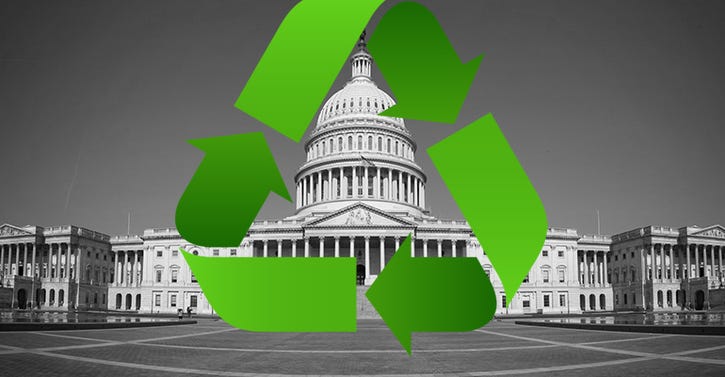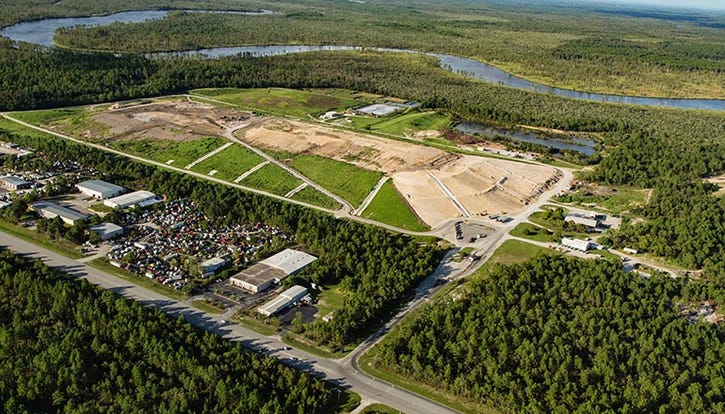Part one of a two-part series details emerging trends and industry experts’ outlook for 2020.

The waste and recycling industry kicked off the new year with a full plate, and industry experts project 2020 could be a transformative one.
The industry continues to respond to the cyclical impact of China’s National Sword and subsequent volatility in recycling markets. Plus, talk of an economic slowdown and the potential for new legislation and regulation in an election year, the impacts of increased merger and acquisition activity and heightened awareness of “forever chemicals” and their potential ramifications for waste management remain top of mind for industry stakeholders this year.
In this two-part series, industry experts discuss emerging trends and their outlook for 2020.
Recycling Markets: Domestic, China and Southeast Asia
From a recycling perspective, 2018 started off unstable due to the implementation of China’s import ban. But 2019 wasn’t much better.
“When you have something bad, the only thing you can do is try to predict something more cheerful, so we, along with a lot of other people, said 2019 will be better. And 2019 was worse,” says Anne Germain, vice president of technical and regulatory affairs for the National Waste & Recycling Association (NWRA). “Commodity prices did not recover; prices for everything went down, with the exception of plastics.”
Germain projects that in 2020, metals prices will stabilize; however, her outlook for cardboard remains bleak.
“Even if China delays an import ban on all fiber, fiber permits are still expected to be reduced. Because of that, we expect commodity prices to remain in the doldrums, and we are hoping that they won’t get any worse,” she says. “But it’s going to be another challenging year from a commodities pricing perspective.”
Longtime industry veteran and Waste360 columnist Chaz Miller also predicts 2020 will be another challenging year for recyclers, with paper markets remaining flat throughout the year. There are, however, some glimmers of hope of rising prices later in the year.
The Pratt Industries mill in Wapakoneta, Ohio, opened in October 2019 and will process 180,000 tons of mixed paper in its first year of operation. That will steadily increase to 360,000 tons in 10 years, says Miller.
“That’s the start of the market for mixed paper, but it’s not enough to buoy markets,” he explains.
Two new paper mills are expected to open at the end of 2020 or in early 2021—the Green Bay Packaging mill in Wisconsin and the Cascades mill in Virginia. Three new Nine Dragons mills have been opaque about when those mills will be fully operational in terms of buying mixed paper, according to Miller, making it difficult to predict what impact they’ll have.
“I think markets will stay relatively flat through 2020. Maybe, at the end of 2020 and early 2021, we’ll start seeing things get better for mixed paper,” Miller projects. “Corrugated will pretty much stay the way it is.”
“I don’t expect China to ban the imports of all recyclables,” he adds. “The paper mills depend too much on it. I am more inclined to think they will ban waste but continue to accept raw materials.”
Plastic markets, however, are a little harder to predict. With a surge in new virgin resin capacity coming online, prices for those resins are likely to drop and depress recycled resin prices, says Miller.
“Many consumer brands announced aggressive goals for the use of recycled plastic,” he explains. “2020 will test their willingness to increase recycled content even if it means paying more for raw materials. I think it’s clearly time for them to step up and start buying now.”

Robin Weiner, president of the Institute of Scrap Recycling Industries (ISRI), anticipates that there will be a continued trend of seeking new global and domestic recycling markets.
“There has been a significant amount of investment in the U.S. in the past year, and I would imagine that we would continue to see that—with investment on both the consumption side and within recycling itself,” explains Weiner. “This will be an expansion for existing facilities as well as greenfield operations. We’re excited about that because the greater market improvements we see, the stronger the business will be. And we will be pushing for any opportunity to strengthen market demand in recycled content and design for recycling.”
ISRI also expects continued challenges for international recycling markets.
“The issue of import restrictions is being discussed in a lot of different markets, and we are being very proactive in Indonesia, Malaysia and other countries discussing the difference between legitimate scrap trade and waste that has been illegally shipped,” says Weiner. “I think one of our biggest challenges going forward is helping importing countries understand the difference. That continues to be a big focus for us.”
David Biderman, executive director and CEO for the Solid Waste Association of North America (SWANA), notes that in 2020, the industry will continue to respond to the evolving impact of China’s National Sword on local recycling programs.
“The inaccurate media narrative that recycling was in some sort of national ‘crisis’ appears to have been effectively rebutted, as new domestic capacity coming online and reductions in contamination levels reported throughout the United States had led to a reduction in the pace of local governments suspending curbside collection,” explains Biderman. “In addition, EPA [the U.S. Environmental Protection Agency] announced at the America Recycles Day (ARD) Summit in November 2019 that it would be proposing national recycling goals this year, and I expect that, together with implementation of the EPA Recycling Framework released at the ARD Summit, will encourage local governments to continue with their recycling programs.”
Bryan Staley, president and CEO of the Environmental Research & Education Foundation (EREF), expects to see more nuanced conversations happening around recycling and sustainable materials management.
“I think some of the issues with the domestic recycling markets and China’s National Sword have really put the spotlight on recycling and asking some hard questions that I don’t think have been asked in the past,” he says. “I think the industry has the opportunity to lead that conversation.”
“I think recycling markets will improve, but I think it will be slow,” adds Staley. “In order to strengthen domestic markets and recycling overall, the best feedstock is going to result in the best end materials and end markets. And that doesn’t seem to be happening right now.”
Economic Outlook, Legislation and Regulation
Another top trend to watch in 2020 is the overall health of the economy. The industry also is watching certain legislative and regulatory activity but doesn’t expect too much to pass in the upcoming presidential election year.
“Later this year or in 2021, there could be a sufficient cooldown for the economy that will impact the industry; we don’t know yet,” explains Staley. “With various geopolitical things happening, you never know how that will affect the economy—good or bad.”

Biderman points out that if the U.S. and Canadian economies continue to hum along at the 2 to 2.5 percent growth range, there will be plenty of waste and recyclables to go around. However, 2019 was the 10th consecutive year of economic growth following the 2008-09 Great Recession, and eventually, the tide will turn, he says.
“Solid waste owners, local governments and others interested in the overall health of the industry should keep a close eye on GDP [gross domestic product] numbers, as they will determine whether the United States or Canada will have a record-breaking 11th consecutive year of economic growth, or if a long-predicted economic downtown is at hand in either late 2020 or 2021,” says Biderman.
In terms of legislation for 2020, Jim Riley, chief counsel and senior vice president of government affairs for NWRA, says a couple things immediately come to mind.
NWRA has been lobbying to get tax extenders renewed since they expired at the end of 2017. NWRA also had its eye on a federal infrastructure bill—both for surface transportation and a broadly defined infrastructure measure that would encompass domestic recycling infrastructure capabilities.
In addition, NWRA ended 2019 on a high note. In November, the Federal Motor Carrier Safety Administration (FMCSA) announced it would grant NWRA an hours of service (HOS) exemption exclusively for its members. The exemption eliminates the need for NWRA member companies to use electronic logging devices (ELDs) in their trucks.
“Congress will not be in session very much next year. We already looked at the 2020 calendar and calculated back in terms of how many days they are going to be there,” explains Riley. “One of the reasons we do that is because of the rulemaking underway from the U.S. Department of Transportation in terms of hours of service. We already have our [HOS] exemption, which is good for five years. But there are some broader hours of service changes that FMCSA is trying to make. And if a Democrat were to win the White House and had control of both the House and Senate after the 2020 election, they could invoke the Congressional Review Act (CRA). That gives them so many days to go back and basically repeal any kind of new rules implemented by the various agencies.”
“That’s why it’s so important that NWRA got its exemption for member companies,” he adds.
Kirk Sander, NWRA’s chief of staff and vice president of safety and standards, explains it’s hard to say how the CRA play would impact the industry.
“We will just be watching if the change is in the next five years. We don’t think it’ll change much, but we haven’t seen the final rule,” he says. “The same thing goes for FMCSA’s entry-level driver training. Indications are there will be pushback, but nothing is official until it’s in the [Federal] Register.”
Typically, not much is accomplished during a presidential election year, but Riley says he wouldn’t rule out passage of a highway bill, which would be separate from the bigger, broader infrastructure package. Riley adds that NWRA has had conversations with people on both sides of the aisle to ensure the passage of a surface transportation infrastructure bill.
“Aside from that, we made sure that domestic recycling infrastructure was included in any broader package,” he says.
As for recycling, NWRA doesn’t anticipate much regulatory activity from the federal government, but Germain projects there will likely be movement put forth at the state level. Congress may also pass either the RECOVER (Realizing the Economic Opportunities and Value of Expanding Recycling) or the RECYCLE (Recycling Enhancements to Collection and Yield through Consumer Learning and Education) Acts, which provide financial support to local government recycling efforts.
Sander says the industry will continue tracking Move Over laws and whether a measure will expand to all vulnerable road workers, including those in waste and recycling.
In addition to the RECOVER and RECYCLE Acts, Miller projects that Congress will pass the Save Our Seas 2.0, which expands the 2018 law.
At the local level, New York City will start the implementation of its controversial commercial waste zone (CWZ) system this year, with a request for proposal (RFP) likely to be issued by June, notes Biderman.
“Although the changes aren’t expected to be fully finalized until 2022 at the earliest, the specter of CWZ, also known as ‘franchising,’ will likely impact the hyper-competitive New York City market, as some carters go out of business and others battle for advantage in this large, important market,” he says.
Mergers and Acquisitions
Another key area to watch is the pace of acquisitions, which has been accelerating over the past few years and has industrywide ramifications. The biggest merger to keep an eye on this year is Waste Management’s acquisition of Advanced Disposal (ADS).
“Acquisitions like the Waste Management/Advanced deal have major ripple effects throughout the industry on the OEM [original equipment manufacturer] side and even on the competitor side and for haulers as well,” explains Staley. “That has impacts on the trade associations and on EREF as an organization.”
In June 2019, ADS' stockholders voted to adopt the merger agreement with Waste Management. The transaction is expected to close by the first quarter of 2020.
“Large national companies, regional players and private equity are all aggressively buying companies, and I expect this will continue in 2020,” says Biderman. “The pending acquisition of Advanced Disposal by Waste Management is expected to result in the divesture of solid waste assets (e.g., disposal facilities and collection) in several markets, which will create additional opportunities for companies to grow. The possibility of a Democrat being elected in November 2020, and a potential subsequent increase in the capital gains or federal income tax rates, may fuel even more deals, at higher multiples, as Election Day nears.”
PFAS and Waste Management
Issues surrounding per- and polyfluoroalkyl substances (PFAS)—known as “forever chemicals”—really began to gain public attention in 2019 with movies like “Dark Waters” and the Netflix documentary, “The Devil We Know.” EREF, which has released an RFP targeting PFAS research, predicts PFAS will be in the crosshairs of the industry for the foreseeable future.
EREF is working on funding for three new contracts to study PFAS in landfill leachate. EREF’s goal is to get a better understanding of PFAS and their impacts on the industry in order to answer looming questions.
“There are still a lot of questions that need to be answered,” stresses Staley. “I‘ve had conversations with folks who suggest that the answers are in on PFAS, and I disagree with that. There’s still a lot of scientific research that is necessary to understand the actual health implications on low-level exposures that we are seeing in our everyday lives.”

Although the House of Representatives passed a bill that included language designating PFAS compounds as hazardous substances under Superfund and directing EPA to set a maximum contaminant level for PFAS under the Safe Drinking Water Act, the language was dropped from the National Defense Authorization Act due to opposition in the Senate.
“SWANA expects this bill to re-emerge this month in the House, but it will likely have difficulty getting traction in the Republican-controlled Senate,” explains Biderman. “Also, EPA is expected to finalize a regulatory determination for certain PFAS compounds this year, and states are aggressively moving forward to fill the void created by federal inaction. Several northeastern and midwestern states have issued or are proposing PFAS standards for drinking water. SWANA is closely monitoring PFAS issues and is developing new resources for members to help them address rising concerns over PFAS in leachate.”
Safety & Technology
At the end of 2019, the U.S. Department of Labor’s Bureau of Labor Statistics released its 2018 National Census of Fatal Occupational Injuries, which revealed an increase in waste collection fatalities.
As safety remains top of mind for industry associations, NWRA is working on an RFP for a 10-year review of safety data on the industry and figuring out where the gaps are, explains Sander. “We are going to announce that winner early in 2020 and our selection on that. So, starting that process and hopefully getting preliminary data in 2020 is exciting for me,” he says.
In addition, Biderman says he hopes the joint SWANA-NWRA Alliance with the U.S. Occupational Safety & Health Administration will help reduce the frequency of fatalities, accidents and injuries in the sector.
At the end of 2019, NWRA also released its best practices guide for materials recovery facilities and temp workers. Sander adds that lithium-ion battery safety will also be a continuing safety trend.

ISRI also projects that the dual issue of lithium-ion batteries and fires will continue to be a huge issue for ISRI moving forward and for all in the stream—whether it’s residential, commercial or industrial. Weiner points out that the waste stream will now include larger ELD batteries and those from electric vehicles, as well as smaller lithium-ion batteries.
“Both are causing safety and fire risks,” she says. “We are being very proactive to try and address the issue from both a policy perspective and operational perspective.”
EREF is also looking to mandate some work in 2020 to drill down fatality statistics.
When it comes to technology, Arnold Bowers, business solutions director at ENGIE Impact, formerly ENGIE Insight, anticipates that bigger, bolder technology solutions will eventually relieve the pressure of municipalities and communities having to enforce plastics bans and legislation. He points to renewed investment in chemical recycling as an efficient way for bottlers to recapture plastic.
Bowers also points out that the proliferation of Internet of Things (IoT) has been a longstanding expansion in the industry. Prior to his work at ENGIE Impact, Bowers worked with an IoT company that builds and supports smart bins.

“There are all these new kinds of monitoring technologies growing, and we are piloting these technologies today to figure out if there is a one size fits all or if there will be different technologies for these sorts of things,” says Bowers.
Technologies include cameras revealing material in a bin, which can help combat contamination. Others are more sonar based and provide more feedback of how full a bin is.
“All this data is closed loop, and it’s from the point of generation, whether it be a bin, at a park, on a college campus or industrial setting, where that bin is being monitored and that data is being sent back to a system that someone is watching,” says Bowers. “Then, resources can be deployed more on-demand rather than the old, historical routing and collection loops. Using the IoT and monitoring technology allows us to conserve our resources as we go out and move materials.”
Bowers also broached the idea of building an “Uber for waste” concept, where trucks are deployed only when bins are full.
“Maybe in the future of waste that could be possible, but the model that collection is built on today is not really prepared for that Uber-type situation,” he says. “But I think we’re prepared for that IoT data to feed back into our collection and help us address and adjust where we can focus our attention. The expansion of all our technology and focus today, in my view, will impact the waste business tremendously over the next decade.”
Part two of this series will highlight the industry’s goals for 2020.
About the Author(s)
You May Also Like




